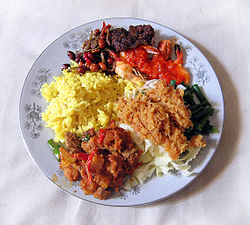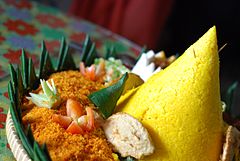Nasi kuning
 Nasi kuning personal serving, surrounded with rich Indonesian dishes | |
| Course | Main course |
|---|---|
| Place of origin | Indonesia |
| Region or state | Nationwide in Indonesia |
| Created by | Javanese |
| Serving temperature | Hot and room temperature |
| Main ingredients | Rice cooked in turmeric surrounded with side dishes |

Nasi Kuning (Indonesian for: "yellow rice"), or sometimes called Nasi Kunyit (Indonesian for: "turmeric rice"), is an Indonesian rice dish cooked with coconut milk and turmeric,[1][2] hence the name nasi kuning (yellow rice). Nasi kuning might come in the form of a cone called a tumpeng and is usually eaten during special events. The rice looks like a pile of gold, so it is often served at parties and opening ceremonies as a symbol of good fortune, wealth and dignity.
It is usually served with a variety of side dishes such as shredded omelette, serundeng (relish of grated coconut and spices), urap (vegetable in shredded coconut dressing), teri kacang (fried anchovy and peanuts), sambal goreng (fried tempeh and potato caramelized in spicy sauce), ayam goreng (Javanese-style fried chicken), balado udang (shrimp in chilli), or perkedel (potato fritters). More elaborate nasi kuning might include fried cow's brain, fried cow's lung, beef and seafood. It is common to serve nasi kuning with kerupuk udang (shrimp cracker) or emping chips and a decoratively cut cucumber and tomato.
The top of the tumpeng is customarily given to the most senior person in attendance.
See also
- List of rice dishes
- Nasi bogana
- Nasi campur
- Nasi goreng
- Nasi kucing
- Nasi lemak
- Nasi liwet
- Nasi pecel
- Nasi tim
- Nasi uduk
- Nasi ulam
 Food portal
Food portal
References
- ^ Helen Agostino, Kathy Kiting, Asia Education Foundation, Indonesia Kaleidoscop, Curriculum Corporation, 1999, 59p. ISBN 1-86366-383-5
- ^ Heinz Von Holzen, Wendy Hutton, Lother Arsana, The Food of Indonesia Tuttle Publishing, 1999, Page 62 ISBN 962-593-389-1
